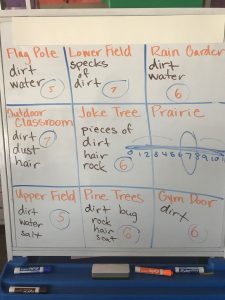Surprises Never Get Old
Usually by now, I am having students use found nature items to make a boat, or looking for symmetry in nature. But this year, we had a two hour delayed start due to fourteen more inches of snow just this past Monday – April 16th! This has forced a bit more creativity in outdoor lesson planning. I don’t mind repeating lessons, and think it’s good for kids to experience the same learning, but at a different time of year. This allows us to compare what happened previously to our most recent adventure as well as note how weather/seasons affects our observations and learning. But, it makes it tricky to repeat a lesson if the seasons won’t change.
This week, as were considering what to do, we decided to try something different. We’ve been noticing lots of snow eating throughout the year and while we discourage it, you know it keeps happening. You and I understand why it might not be the best idea, but we realized that to a kid, we are just another adult telling them to stop doing something they love. We thought the best way to help kids understand the why was with science.
Before going out, we talked about locations we might want to check as well as what things might be in snow. We came up with nine locations we were curious about, and students brainstormed a pretty accurate list of what we might find: dirt, sand, scat, salt etc… This also opened up the door for me to introduce pH as a piece of data we can add to our observations. I did a very general overview of the scale, how pH paper worked and demonstrated on tap water to show neutral. Then, we packed up and headed out.
Despite the recent snow, we noticed that spring was working hard to pop out. There was way more bird activity than previous weeks. We also noticed the huge amounts of salt on our sidewalks, particularly by the flagpole. As we continued our walk, we noticed how crunchy the snow was on top, how deep the snow still was and places that looked like clean snow.
Once we got into the forest, it became apparent that many other animals are ready for spring to come too! The deer apparently like using our trail as much as we do. We found evidence of two way traffic even. Was one in the morning and one at night? Was it the same deer or different deer? We also found lots of squirrel and rabbit tracks, saw chickadees, nuthatches, juncos, and even a woodpecker. Part way down the trail we also found a huge flattened out section of snow covered in clumps of fur next to a stick that had clearly been chewed on.
We paused at this spot for quite awhile, letting students speculate about what animal it might have come from and what might have caused so much fur to come off. It was super interesting to me how many students jumped right to beaver because of the chew marks, despite being a good mile from a pond. We also had recently spotted a bald eagle around our school yard, leading some to wonder if the eagle had a lunch. At the end of the trail we even found some goose prints in the snow – a first for me.
All of these finds, questions, wonderings and guesses reminded me again of the wonderment caused by simply being outside and paying attention to where you are. I don’t regret having our plan, in fact Mrs. Lyons followed up with students the following day and found some interesting results with the snow we collected. 
However, I was reminded yet again that sometimes the best lessons aren’t the ones we plan but the ones we discover. While our main purpose was to be out collecting snow, students also got a chance to observe sights, sounds and textures, find patterns, make guesses, ask questions and wonder. These are all good skills to have, but seeing them practiced and used in such an authentic setting make them seem even more valuable. I shouldn’t be surprised any more by our surprise finds or side bar learning, but somehow I always am. I guess a good surprise never gets old for me.
2 thoughts on “Surprises Never Get Old”
I love this, Jill! Thank you for sharing your experiences. This gets me thinking about what I might do with my young scientists.
Thanks Tanner! Glad to hear my reflections inspire you.